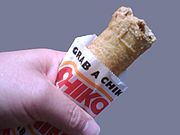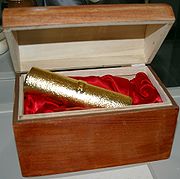
Chiko Roll
Encyclopedia


Chinese cuisine
Chinese cuisine is any of several styles originating in the regions of China, some of which have become highly popular in other parts of the world – from Asia to the Americas, Australia, Western Europe and Southern Africa...
egg roll
Egg roll
An egg roll is an appetizer and dinner, a variant of spring roll that has spread throughout the world as a staple of Asian cuisine. Egg rolls with fillings are commonly served in Vietnamese cuisine.-Description:...
and spring roll
Spring roll
Spring rolls is an umbrella term used in some Western cultures to describe disparate varieties of filled, rolled appetizers similar to the Chinese chūn juǎn , from which the term was derived...
s. It was designed to be easily eaten on the move without a plate or cutlery. The Chiko roll consists of beef, celery
Celery
Apium graveolens is a plant species in the family Apiaceae commonly known as celery or celeriac , depending on whether the petioles or roots are eaten: celery refers to the former and celeriac to the latter. Apium graveolens grows to 1 m tall...
, cabbage
Cabbage
Cabbage is a popular cultivar of the species Brassica oleracea Linne of the Family Brassicaceae and is a leafy green vegetable...
, barley
Barley
Barley is a major cereal grain, a member of the grass family. It serves as a major animal fodder, as a base malt for beer and certain distilled beverages, and as a component of various health foods...
, carrot
Carrot
The carrot is a root vegetable, usually orange in colour, though purple, red, white, and yellow varieties exist. It has a crisp texture when fresh...
, onion, green beans, and spices in a tube of egg
Egg (food)
Eggs are laid by females of many different species, including birds, reptiles, amphibians, and fish, and have probably been eaten by mankind for millennia. Bird and reptile eggs consist of a protective eggshell, albumen , and vitellus , contained within various thin membranes...
, flour
Flour
Flour is a powder which is made by grinding cereal grains, other seeds or roots . It is the main ingredient of bread, which is a staple food for many cultures, making the availability of adequate supplies of flour a major economic and political issue at various times throughout history...
and dough
Dough
Dough is a paste made out of any cereals or leguminous crops by mixing flour with a small amount of water and/or other liquid. This process is a precursor to making a wide variety of foodstuffs, particularly breads and bread-based items , flatbreads, noodles, pastry, and similar items)...
which is then deep-fried. The wrap was designed to be unusually thick so it would survive handling at football
Australian rules football
Australian rules football, officially known as Australian football, also called football, Aussie rules or footy is a sport played between two teams of 22 players on either...
matches. It was originally called a "Chicken roll" despite not containing any chicken
Chicken
The chicken is a domesticated fowl, a subspecies of the Red Junglefowl. As one of the most common and widespread domestic animals, and with a population of more than 24 billion in 2003, there are more chickens in the world than any other species of bird...
then later renamed "Chiko Roll". At the peak of their popularity in the 1960s and 1970s, tens of millions of Chiko Rolls were sold annually in Australia, and the product has been described as an Australian cultural icon.
History
The Chiko Roll was developed by Frank McEncroeFrank McEncroe
Francis Gerard "Frank" McEncroe was an Australian businessman. He is known for his invention of the Australian fast food phenomenon, the Chiko Roll.-Early life and career:...
, a boilermaker
Boilermaker
A boilermaker is a trained craftsman who produces steel fabrications from plates and sections. The name originated from craftsmen who would fabricate boilers, but they may work on projects as diverse as bridges to blast furnaces to the construction of mining equipment.-Boilermaking:Many...
from Bendigo
Bendigo, Victoria
Bendigo is a major regional city in the state of Victoria, Australia, located very close to the geographical centre of the state and approximately north west of the state capital Melbourne. It is the second largest inland city and fourth most populous city in the state. The estimated urban...
who turned to catering at football matches and other outdoor events. In 1950, McEncroe saw a competitor selling Chinese chop suey rolls outside Richmond Cricket Ground and decided to add a similar product to his own line. McEncroe felt that the Chinese rolls were too flimsy to be easily handled in an informal outdoor setting, and hit upon the idea of a much larger and more robust roll that would provide a quick meal that was both reasonably substantial and easily handled. The result was the Chiko Roll, which debuted at the Wagga Wagga Agriculture Show in 1951.
In the 1960s, McEncroe moved to Melbourne with his family where he began to manufacture the rolls with the help of a sausage machine. As the product became more popular, McEncroe moved to a larger factory with more modern equipment in North Essendon and later merged with a local company called Floyd's Iceworks to form Frozen Food Industries Pty Ltd. The new company went public in 1963.
By 1965, most Australian takeaway
Take-out
Take-out or takeout , carry-out , take-away , parcel , or tapau , is food purchased at a...
restaurants and fish and chip shops carried Chiko Rolls, with the marketing slogan 'Grab a Chiko' signifying the ease with which shop owners could take a Chiko Roll from the freezer and pop it into a fryer and slide it into its own trade mark bag. At the height of their popularity in the 1970s, 40 million Chiko Rolls were being sold Australia-wide each year and more than one million were exported to Japan.
Increasing competition in the Australian takeaway food market in recent decades has seen a decline in the profile of the Chiko Roll, but they are still widely available at fish and chips shops and supermarkets across Australia.
Chiko Chick
Since the 1950s, Chiko Rolls have been advertised by an iconic "girl on a motorbike" (also known as the "Chiko Chick") theme. The girl is usually photographed straddling a Harley Davidson motorcycle, holding the Chiko Roll near her crotch in a phallic gesture. The accompanying slogan is "Couldn't you go a Chiko Roll?".During the early 1980s, the accompanying slogan for Chiko roll was "You can't knock the roll".
The company subsequently indicated a desire to promote the product using a more wholesome, "girl next door" image. On 17 July 2008, the new advertising poster was unveiled at the Wagga Wagga Showgrounds.
Present
Since 1995, the Chiko brand has been owned by Simplot AustraliaSimplot
The J. R. Simplot Company, commonly referred to as Simplot, was founded in 1923 by 14-year-old J. R. Simplot near the small agricultural community of Declo in south central Idaho. J. R. Simplot led his company to tremendous growth in the period between its founding and World War II...
and today has expanded its products to include: MexCHIKO Rolls, Corn Fritters
Corn fritters
Corn Fritters are a savory snack. Traditional corn fritters are a mixture of corn kernels, egg, flour, milk, and melted butter. They can be deep fried, shallow fried, or baked and served with jam, fruit, honey, or cream. They may also be made with creamed corn, baked, and served with maple syrup.-...
, Corn Jacks, fish cakes, Spring Rolls, Veggie Nuggets, Beef Croquettes and dim sim
Dim sim
A dim sim is a Chinese-inspired meat dumpling-style snack food popular in Australia. The dish normally consists of a large ball of pork or other meat, cabbage and flavourings, encased in a wrapper similar to that of a traditional shumai dumpling. They are usually deep-fried or steamed, but can be...
s. All Chiko Rolls are now manufactured in Bathurst
Bathurst, New South Wales
-CBD and suburbs:Bathurst's CBD is located on William, George, Howick, Russell, and Durham Streets. The CBD is approximately 25 hectares and surrounds two city blocks. Within this block layout is banking, government services, shopping centres, retail shops, a park* and monuments...
, New South Wales
New South Wales
New South Wales is a state of :Australia, located in the east of the country. It is bordered by Queensland, Victoria and South Australia to the north, south and west respectively. To the east, the state is bordered by the Tasman Sea, which forms part of the Pacific Ocean. New South Wales...
, Australia, on a specifically designed machine that produces the pastry and filling at the same time in long rolls. They are then automatically sliced and then the distinctive ends are folded.

